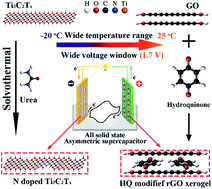A novel all solid-state asymmetric supercapacitor with superior electrochemical performance in a wide temperature range using a hydroquinone modified graphene xerogel as the cathode and N-doped Ti3C2Tx as the anode†
Abstract
To further improve the energy density of supercapacitors, novel asymmetric supercapacitors using electrode materials with a large potential window should be designed. In this report, a hydroquinone modified graphene xerogel as the cathode and N-doped Ti3C2Tx as the anode are first applied in all-solid-state asymmetric supercapacitors with a wide voltage window. The hydroquinone modified binder-free graphene xerogels are chosen as the cathode materials because of their high potential, high pseudocapacitance, and high conductivity, whereas the N-doped Ti3C2Tx are selected as the anode materials due to their low potential, high specific capacitance, and high conductivity. The as-fabricated asymmetric device shows a potential window of 1.7 V in a H2SO4 gel electrolyte, and excellent adaptability in a wide temperature range from room temperature to −20 °C. It is found that an excellent energy density of 33.9 W h kg−1 for the asymmetric supercapacitor is achieved at −20 °C. Furthermore, the operation of the asymmetric supercapacitor in a wide temperature range greatly increases the practical application potential of supercapacitors.



 Please wait while we load your content...
Please wait while we load your content...